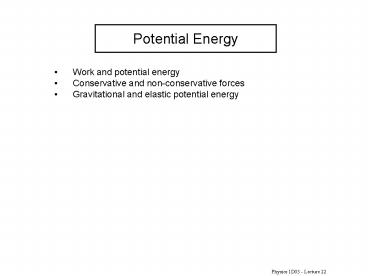Potential Energy - PowerPoint PPT Presentation
1 / 12
Title:
Potential Energy
Description:
Potential Energy Work and potential energy Conservative and non-conservative forces Gravitational and elastic potential energy Example A rock of mass 1kg is released ... – PowerPoint PPT presentation
Number of Views:44
Avg rating:3.0/5.0
Title: Potential Energy
1
Potential Energy
- Work and potential energy
- Conservative and non-conservative forces
- Gravitational and elastic potential energy
2
Gravitational Work
To lift the block to a height y requires work (by
FP ) WP FPy mgy
When the block is lowered, gravity does
work Wg1 mg.s1 mgy or, taking a different
route Wg2 mg.s2 mgy
3
Work done (against gravity) to lift the box is
stored as gravitational potential energy Ug
Ug (weight) x (height) mgy (uniform g)
When the block moves, (work by
gravity) P.E. lost
Wg -DUg
- The position where Ug 0 is arbitrary.
- Ug is a function of position only. (It depends
only on the relative positions of the earth and
the block.) - The work Wg depends only on the initial and
final heights, NOT on the path.
4
Example
- A rock of mass 1kg is released from rest from a
10m tall building. What is its speed as it hits
the ground ? - The same rock is thrown with a velocity of 10m/s
at an angle of 45o above the horizontal. What is
its speed as it hits the ground.
5
Conservative Forces
path 1
B
A force is called conservative if the work done
(in going from A to B) is the same for all paths
from A to B.
A
path 2
W1 W2
An equivalent definition For a conservative
force, the work done on any closed path is zero.
Total work is zero.
6
Concept Quiz
The diagram at right shows a force which varies
with position. Is this a conservative force?
- Yes.
- No.
- We cant really tell.
- Maybe, maybe not.
7
For every conservative force, we can define a
potential energy function U so that WAB -DU
UA -UB
Note the negative
Examples Gravity (uniform g) Ug mgy,
where y is height Gravity (exact, for two
particles, a distance r apart)
Ug - GMm/r, where M and m are the masses
Ideal spring Us ½ kx2, where x is the
stretch Electrostatic forces (well do this in
January)
8
- Non-conservative forces
- friction
- drag forces in fluids (e.g., air resistance)
Friction forces are always opposite to v (the
direction of f changes as v changes). Work done
to overcome friction is not stored as potential
energy, but converted to thermal energy.
9
Conservation of mechanical energy
If only conservative forces do work, potential
energy is converted into kinetic energy or vice
versa, leaving the total constant. Define the
mechanical energy E as the sum of kinetic and
potential energy
E ? K U K Ug Us ...
Conservative forces only W -DU Work-energy
theorem W DK So, DKDU 0 which
means that E does not change with time
dE/dt 0
10
Example Pendulum
L
- The pendulum is released from rest with the
string horizontal. - Find the speed at the lowest point (in terms of
the length L of the string).
vf
11
Example Pendulum
?
- The pendulum is released from rest at an angle ?
to the vertical. - Find the speed at the lowest point (in terms of
the length L of the string).
vf
12
Example Block and spring
v0
A block of mass m 2.0 kg slides at speed v0
3.0 m/s along a frictionless table towards a
spring of stiffness k 450 N/m. How far will the
spring compress before the block stops?

